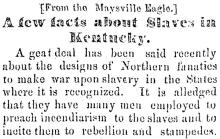[From the Maysville Eagle.]
A few facts about Slaves in Kentucky.
A great deal has been said recently about the designs of Northern fanatics to make war upon slavery in the States where it is recognized. It is alleged that they have many men employed to preach incendiarism to the slaves and to incited them to rebellion and stampedes. And according to the sensation mongers Kentucky is especially marked as the scene of the exploits of those zealots. Moreover, such have been the complaints of the past depredations, that without examining the facts one would suppose that slavery was being rapidly eradicated from Kentucky, that the tenure of slave property in this State is so insecure that slaves were being sent to latitudes out of the reach of the disciples of Wendell Phillips and Loyd Garrison. It may not be amiss, therefore, at this time, to publish a few facts in reference to the institution in this State, in order that we may see whether the insecurity of the property of Kentuckians in slaves, in the Union, has been such as to render secession necessary for its protection. Our figures are taken from the Auditor's Report for the year 1858, the last which has been circulated.
The entire number of slaves in Kentucky in 1857 was 201,594; in 1858 it was 207,338; an increase in one year of 5744. The natural increase of population, without immigration, would have been about 4,000. We find then, that notwithstanding the large number which have been carried to the cotton States, there have been importations in to the State which more importations in to the State which more than counter-balance them by far. The increase of slaves over 16 years of age for the same year was 864, more than the natural increase. The increased value was $1,135,830.
The entire number of slaves in the counties bordering on the Ohio River from the mouth of the Big Sandy to the mouth of the Kentucky, in 1858, was 9,098; and increase of 287 which is more than the natural increase, placing it at two per cent. In the counties bordering on the Ohio and Mississippi, from the mouth of the Kentucky to the Tennessee line, the entire number of slaves in the slaves in the same year was 36.15, an increase of 482 which is a little less than the natural increase.
The slight falling off, however, may be easily accounted for by the large increase of slaves in the counties immediately back of those on the border. A careful examination of the Report will show that the increase of working hands is far greater in proportion than the entire increase of slaves, which is demonstrative proof that there has been a large importation into the State. These facts of themselves prove that the institution is profitable in Kentucky, and that its insecurity is not such as to prevent capital from being invested in negroes.
Still, Kentucky has lost many negroes, and is entitled to all the guards the Federal Government can give against their escape. Negroes have legs and will occasionally run off. If they did not go North, they would take to the mountains and subject by plunder. They ran off into the swamps of Georgia and Florida where incendiaries are rarely heard of. It is manifestly unfair then to argue that the North is to blame for every negro who takes to his heels.
"A few facts about Slaves in Kentucky," Ripley (OH) Bee, December 27, 1860, p. 3.

